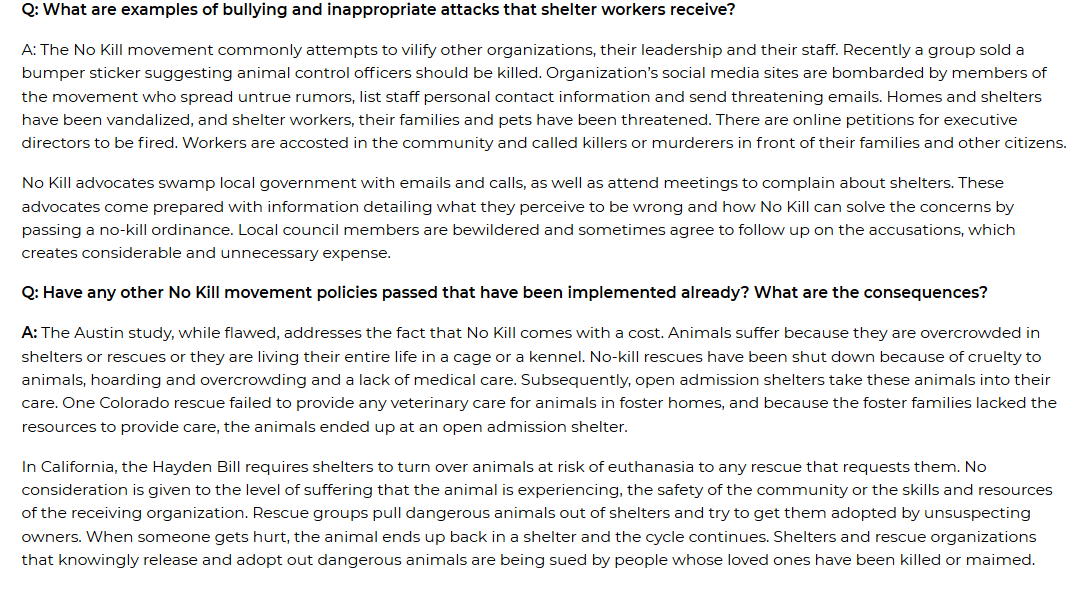|
I’m hearing a lot of chatter these days about a new phrase which is making the rounds: Socially Conscious Sheltering. Like many phrases used in animal welfare circles, the meaning of the phrase isn’t clear from the words used so I did some poking around to educate myself. What I found was disturbing. I am waiting for some voices louder than mine on the national stage to take on this issue, but am sharing my thoughts to get some conversations started. According to a page on the website for the Denver Dumb Friends League in Colorado: Socially conscious sheltering’s fundamental goal is to create the best outcomes for all animals. The noted best outcomes are reached by striving for the “Five Freedoms,” which were developed in the United Kingdom in 1965. A simple search about the Five Freedoms reveals that the origins of the freedoms relate to what is commonly referred to as “livestock production systems.” In 1964, a British woman named Ruth Harrison wrote a book called “Animal Machines” which described intensive livestock and poultry farming practices. Due to public outcry about the book, the British Government formed a committee to examine the way farm animals were treated. The committee presented a report in 1965 that concluded that farm animals should have the freedom to "stand up, lie down, turn around, groom themselves and stretch their limbs.” After the report was published, another committee was created to monitor livestock production leading to the “Five Freedoms” being codified (made law). They have since been adopted by a host of organizations and professional groups around the globe. The Five Freedoms are:
The Five Freedoms should not be controversial related to shelter animals. Surely all of us can agree that animals deserve to be properly cared for and should be free from hunger, thirst, discomfort, pain, injury, disease, fear, distress and should be able to express normal behavior. The problem arises when we try to apply these freedoms to animal shelters and the interpretation of what the words mean related to whether or not animals are kept alive. Hunger and thirst are easily addressed by any animal shelter. Shelter animals should have continuous access to clean water and should be fed a nutritious diet daily. Discomfort is easy to understand and should be easy to address. Animals in shelters should be housed in such a way that they are protected from the elements and have a comfortable place to sleep. Pain, injury or disease are also not complicated issues for animal shelters. Shelters should take immediate steps to alleviate pain, treat (or prevent) injuries and treat (or prevent) diseases. Expressing normal behavior becomes a little more complicated. What is normal to one person may not be normal to another. The reality is that most animal shelters are designed in ways which negate the ability for animals to behave normally. Dogs, which are pack animals, are normally housed by themselves in narrow kennels in which they can smell and hear other dogs, and may be able to see some dogs, but cannot get to those dogs. The kennels are ordinarily in rows which face each other allowing room for staff, volunteers and members of the public to view or access the dogs. It should come as no surprise that dogs in shelters do not behave normally due to the shelter itself more than a reflection of how they would normally behave. Dogs in shelters often show barrier aggression (which is really not aggression at all) and can display stress behaviors like pacing, jumping and barking. The situation for cats in most shelters is not much different. Most shelters house cats by themselves in stacked, stainless steel kennels. They can smell and hear other cats they more often than not cannot see and there is little room for movement. Fear and distress are also more complicated – many animals will behave in ways which show fear and distress inside the animal shelter for the same reasons they do not “express normal behavior.” Some dogs show fear-based aggression or barrier aggression which is not surprising in light of the manner in which they are housed. Cats often exhibit some form of distress due to being housed in small kennels. As much as we would all like to believe that we all want the same things for shelter animals, the reality is that is not the case. We are not all on the same page. Some shelters treat all animals as individuals who either were, or could become, someone’s beloved pet. They go to great lengths to explore all possible options to ensure animals leave the building alive and go on to lead wonderful lives with new families. Other shelters are not quite as progressive. They view the animals in their buildings as being there due to the fault of the irresponsible public which do not make enough good choices and which treat animals as if they are disposable (when, in fact, it is the shelter which is behaving that way by destroying healthy and treatable animals). Even if we all agree that the Five Freedoms are good in principle, using those guidelines to make decisions about which animals live and die is another matter. If a dog does not behave normally in a shelter due to the shelter environment itself, does that make it permissible to destroy that dog? If a cat is fearful and in distress because it is housed in a small kennel day after day after day, do we say that cat is “suffering mentally” and tell ourselves we are saving that cat from a fate worse than death by ending the cat's life? In some shelters, those are the very decisions being made. The Five Freedoms should be considered in light of why they were developed and when they were developed. They were created more than 50 years ago related not to companion animals, but to livestock. This does not mean they have no application to animals in our nation’s shelters. What it does mean is that the words should not be used to provide cover to regressive animal shelters which have not kept pace with programs and services being used across the country (and which have been known for a couple of decades) to keep shelter animals alive while ensuring they are properly housed, cared for and provided with enrichment opportunities. They words should not provide political cover to go back in time to a period in our history when animals were killed because it was easier than saving them or because death was seen as a better alternative to being housed in an animal shelter. My biggest concern thus far with the concept of Socially Conscious Sheltering is the idea that it is somehow better than, or in conflict with, no kill philosophies. Much to my disappointment, the website for the Denver Dumb Friends League goes on to state the following:
In the no kill movement, the phrase “no kill” means we do not destroy healthy and treatable animals. Period. The No Kill Equation which was developed by Nathan Winograd and is being used by animal shelters across the country serves to both keep animals from entering shelters in the first place and serves to move them through the animal shelter as quickly as possible. No kill philosophies do not promote “sheltering homeless animals with the intention of keeping them alive indefinitely irrespective to the pet’s level of suffering.” They serve to treat all animals as individuals who are worth of our attention, time, patience and commitment to keep them alive. It is also not helpful to say that no kill proponents “often spread misleading and inaccurate information which, unfortunately, is believed by many people.” That is a loaded statement for which no details, examples or support has been provided at all. The Denver Dumb Friends League is not the only organization which promotes Socially Conscious Sheltering while at the same time making the no kill movement seem irresponsible and uncaring. A simple Google search for the phrase results in a number of hits. I found a full page of information on the subject on the website for the Santa Cruz Animal Shelter in California which credits the content to the President and CEO of the Denver Dumb Friends League, the President and CEO of the Humane Society of Pikes Peake Region and the CEO of the Humane Society of Boulder Valley, all in Colorado. This website states that Socially Conscious Sheltering is being “slaughtered by the No Kill Movement” (perhaps not the best choice of words) and that “No Kill is Slow Kill.” In April, the Colorado Veterinary Medical Association Board approved a position statement “supporting the socially conscious animal community movement and opposing the no kill movement in animal welfare." According to the CVMA website, the no kill movement increases animal suffering, threatens public health, causes animals to languish in cases, causes dangerous dogs to be placed in the community, and puts animal welfare at risk. I would honestly like to see support for those statements, if they even exist. I am the first to admit that there are some organizations which use the no kill phrase in ways which do not comport with no kill as a social movement, but those places do not represent the entire movement any more than the criminal behavior of some backyard breeders represent the entire breeding industry or any more than the collecting behavior of some animal rescue groups represents all animal rescue groups. Wow. Just wow. We sometimes joke in the state where I live, Alabama, that time travel really is possible. It just depends on where you go and who lives there. There are antiquated beliefs and values to be found across the state which have not kept pace with the rest of modern society. As much as Colorado has a national reputation as being progression on a number of fronts, it appears that the state has taken a trip back in time when it comes to animal sheltering concepts, relying not on the progressive and genuinely successful programs of the No Kill Equation, but instead focusing on a set of freedoms developed more than fifty years ago. Perhaps we should not be surprised when we consider that BSL (Breed Specific Legislation) is still alive and well in Denver even though it has proven to be ineffective. I feel confident my dog will never end up in an animal shelter. Having said that, if he did end up in an animal shelter, I want the shelter to function using no kill programs and services to help him while still providing the Five Freedoms. I want him to have access to nutritional food and clean water. I want him to be housed in a place that keeps him safe from the elements and allows him to sleep comfortably. I want him to have the ability to go outside for walks, to run and play, and to interact with other dogs. I want him to have enrichment using toys, treats and by participating in play groups. If he acts fearful or stressed, I want him to be given opportunities to express normal behavior outside of the building and not be judged by how he behaves in a small kennel. If he hides in the back of his kennel or paces, I don’t want him destroyed because someone thought he was “suffering” and felt that death must be a better alternative. If he stays in the shelter for a few weeks without being adopted, I don’t want him destroyed because of some fabricated expiration date which says he has been there too long. The dog I’m speaking about was in a municipal animal shelter for over a month before we adopted him. He lacked manners. He was heart worm positive. He was kept alive and we thankfully found him. Had he been housed in an animal shelter in some places in Colorado, I do not have confidence his outcome would have been the same. And that would have been a tragedy. If you’re not sure how you feel about Socially Conscious Sheltering as a “better” alternative to the no kill movement, think what you would want for your own animals. I know my answer. What’s yours? Note: After I published my blog the Denver Dumb Friends League modified the Socially Conscious Sheltering page of the website to remove the text I quoted above. It still, however, has a FAQs page which contains the following language which I find incredibly unhelpful. Who is being divisive now?
As I stated above, trying to describe all no kill advocates in such broad generalizations is disingenuous. Stating the Austin study was "flawed" while providing no information to back that up in any way is also misleading.
3 Comments
It’s official. I’ve written a book. I never planned to, but life sometimes takes us down paths we did not expect. This is one of them for me. In August of 2018, I had a meeting with documentary film maker Anne Taiz about the second of two films she’s working on related to the no kill movement. The first film focuses on San Francisco. It is in final editing now. The second film Anne hopes to make focuses on different places across the country where animal shelter reform has happened. Anne and I met to talk about the work of an advocacy group I lead called No Kill Huntsville which has worked for years to change the culture in the community regarding how the animal shelter functions using tax dollars. At one point in our conversation, Anne paused and said, “you should really write a book.” I scoffed at the time. I think I may even have laughed. A book? Really? Who would read it? Would it really help anyone? I discounted the idea and moved on. I formed No Kill Huntsville in 2012, when my individual efforts to encourage the city where I work to change (which began in 2008) fell short. I believed I had been easily dismissed advocating on my own and felt that a small coalition of advocates speaking with one voice may be more effective. At the time we began our advocacy, the live release rate at the shelter was 34% which means that two out of every three animals were destroyed. The situation in Huntsville was depressing, infuriating and exasperating. We felt, and still feel, that the city is far too progressive to destroy healthy and treatable animals just because that was what had been done for years. Fast forward a few years and things have change drastically as a result of our advocacy, members of the public who spoke out and asked for better use of tax dollars and municipal leadership. To say ours was a struggle would be an understatement. We spent years working our issue 7 days a week in the face of a great deal of opposition, much of which came from the rescue community. After the city began making changes, we began to shift our focus to promoting a Companion Animal Protection Act which we called the Huntsville Animal Protection Act. This is local legislation that sets basic standards for the operation of the animal shelter, codifying the standards so they are maintained regardless of who runs the shelter and who leads the city. We had support for HAPA on the council, but the city decided to revise Chapter 5 of the city code, which governs the subject of animals for the entire city. This means that it covers not just the animal shelter operation, but also laws about licensing, animals running at large, violations, and penalties for those violations. In October 2018, we learned that the HAPA as we had written it would not be included in the city’s revisions to Chapter 5 of the city code, but that about 80 percent of what we had proposed would be included. One of the provisions we felt most strongly about—the language about the live release rate not falling below 90 percent—did not make the cut. (We had the percentage in the language not as a goal, but as a stop gap measure to prevent the city from ever returning to a time when the vast majority of animals in the shelter died there). We were told that the city did not want to legislate outcomes. We were disappointed, but we knew there was little we could do to change the city’s position. We did not get the HAPA in quite the form we had hoped. What we did get was strong language regarding the city's intent regarding animal welfare and the shelter operation (and assurances that some of the language included in the HAPA would be included in policy revisions rather than being codified as part of the law for the city). After our work to promote the Huntsville Animal Protection Act was suspended in late 2017, I thought back to how many times we have been contacted by advocates in other parts of the state, other states, and even other countries asking for help. It was then that I decided to write the book, hoping that it would of value to others. Each country, state, and community are different, but some concepts are universal related to the nature of advocacy and the opposition to change. I do not consider the Huntsville story to be the success story I had hoped for or which we have seen in other places. It took years for change to occur and there is much work to be done by city officials moving forward, particularly to keep more dogs alive. There are a variety of things we have asked the city to do which do not cost anything, or for which there is support on the council for some limited spending, which have yet to be considered. I can only speculate as to why that is, based on our history with some city officials who cannot hear the message from us and can only hear it from other sources.
My book is available on Amazon, thanks to the company’s self-publishing platform. It is priced to print which means no money is being made on the book. Although I initially planned to write to book to help other animal advocates, I included enough information and wrote it in a way that I hope it also helps people who care about animal welfare, but don’t consider themselves advocates. I also hope it is of use to elected officials, animal shelter staff and members of the animal rescue community. Every community has the potential to be a no kill community. Sometimes it just takes the courage to try something new. And sometimes it just takes a group of people willing to band together and speak out with one voice to say, “enough. We are better than this.” |
AuthorI am an animal welfare advocate. My goal is to help people understand some basic issues related to companion animals in America. Awareness leads to education leads to action leads to change. Archives
July 2024
Categories
All
image courtesy of Terrah Johnson
|







 RSS Feed
RSS Feed